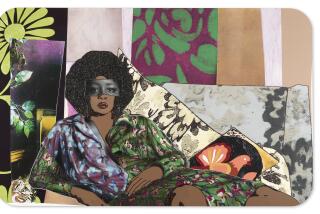Inaugural Show by Washington Organization : Women and the Arts Museum Tests Its Premise in Exhibit
SAN DIEGO — Why have there been no great women artists? The question as posed by art historian Linda Nochlin in a seminal 1971 article was meant to challenge the very assumptions and negative implications behind such a query. The answer, she wrote, lies in a scrupulous examination of the educational and institutional support available to women artists, past and present.
The truth--and the illustrations to Nochlin’s article prove it--is that despite adverse conditions both professionally and personally, women have been creating important art for centuries. Most of it, however, has remained obscure, overshadowed by the work of male artists, who have traditionally dominated “mainstream” art.
The National Museum of Women in the Arts has come to the rescue--or has it? The museum opened in Washington, D.C. in the spring with a mission to organize and host exhibitions composed solely of work by women artists and to serve as a center for research on women in the arts.
No one has disputed the merit of having such a specialized research facility, but the notion of a single-sex museum has been hotly debated. One camp argues that the museum will correct the mistakes of history by focusing attention on long-overlooked women artists. The other asserts that this approach is misguided, that instead of integrating women into the prominent art histories, museum collections and exhibitions, the museum will relegate them to a second-class institution, a female ghetto.
The museum’s inaugural exhibition, “American Women Artists 1830-1930,” has been the first occasion for the public at large to test the validity of the museum’s premise. But the show, on view through Jan. 31 at the San Diego Museum of Art, deserves only a passing grade. Although it does offer much newly excavated material, a great quantity of that material is of only academic interest. With so much of it in the show, the exhibition, intended as a demonstration of artistic excellence, instead comes across as a patchwork of brilliance and mediocrity.
The period of the exhibition marks a century of transition for women artists. In 1830, women were denied access to academic training in drawing from the nude model, thereby being prevented from attaining either the proficiency or the credentials for artistic success. By the time women were able to participate in such training--near the turn of the century-- its importance had waned. By 1930, in fact, academic affiliation was considered meaningless, or worse, retrogressive in contemporary art circles--and women, albeit still a minority of artists, were helping introduce modernism to this country.
Exhibition curator Eleanor Tufts, in attempting to demonstrate the proficiency of women in all genres during this period of change, organized the show according to categories of portraiture, genre and history, landscape, sculpture and still-life. Works are arranged in roughly chronological order within each category. This structure, although it shows that women were indeed active in a range of artistic ventures paralleling men’s, emphasizes breadth at the expense of quality.
The sculpture section of the show makes this abundantly clear. Few of its works transcend the deadening predictability that characterized 19th-Century academic sculpture.
The show’s other sections display a much wider, healthier range of expression, although they are all burdened by works of dry, standardized vision or of only saccharine, anecdotal appeal.
A selection of portraits by Sarah Miriam Peale from the 1830s and ‘40s, however, although wholly indebted to the conventions of the age, reveal the artist’s sensitivity to her subjects and her adept handling of form, light and texture.
As the 19th Century progressed, the conventional approach to portraiture adapted by Peale, with subjects stiffly posed, seated or standing at a slight angle before neutral or ennobling backgrounds, began to be relaxed. Sitters’ individual characters started to emerge, revealed through posture, expression or personal environment. Of the several portraits of artists, either at work or accompanied by the tools of their trade, Margaret Foster Richardson’s “Self-Portrait, A Motion Picture” (1912) is the most remarkable. The artist depicts herself in painting smock, brushes in hand, sweeping laterally through space as if on a determined course toward an awaiting canvas.
Portraits with a strong sense of place and personality by Cecilia Beaux and scattered works of interest by Ellen Day Hale, Romaine Goddard Brooks and Mary Cassatt also are highlights of the portraiture section.
More to Read
The biggest entertainment stories
Get our big stories about Hollywood, film, television, music, arts, culture and more right in your inbox as soon as they publish.
You may occasionally receive promotional content from the Los Angeles Times.










